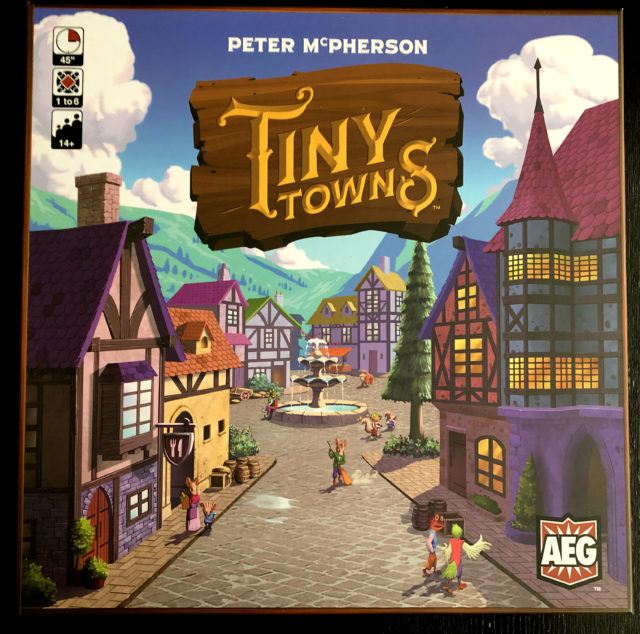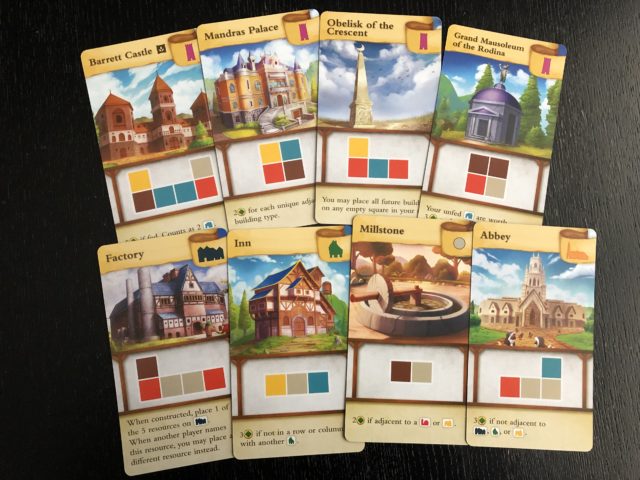((Note on the title: The Terror of Tiny Town was a 1938 musical western that had a cast consisting entirely of little people, except for the MC who opens and introduces the action. I watched it so you don’t have to.))
It is a rare feeling to play a game and get the immediate sensation that you’re playing a future Spiel des Jahres winner–or at least a game that is going to leap out and grab everyone’s attention really soon. That is the feeling I had playing Tiny Towns.
I hope you understand that I am not usually given to such hyperbole–and I have no connection with Tiny Towns’ publisher (AEG) or its designer, Peter McPherson. But it has such an elegant simplicity, loads of replayability, two distinct modes of play, includes a solo mode, as well as the potential for many expansions. It’s an accomplishment.

In many ways I am reminded of Dominion. For one, Tiny Towns is a first-time published design. When Dominion came out, there were people who thought Donald X. Vaccarino was a pseudonym, he was so unknown. Now look at this picture of McPherson! Are you telling me it doesn’t look like the sort of picture someone would pick to mask their true identity? It looks like something out of an LL Bean Catalog!
And yet, when I picked up the box in my FLGS, I put it back almost immediately, so toylike did it look. I saw 4 x 4 grids with cubes and cute little building meeples, and I thought it was a ripoff of last year’s Reef. It wasn’t until I read some of the comments on BGG that I started to think I had (gasp) judged too soon. I never do that!
Tiny Towns’ main mechanic draws inspiration from the myriad of “merge” game apps out there, like Merge Dragons or Merge Farm. Players add resource cubes to empty spaces their grids, one to a space; when the right resources are in the right configuration of spaces they can trade them in for one of eight kinds of buildings, with the building going in one of the vacated spaces. Merging, see?
Eventually, buildings take up so much room that no more merging is possible, and that player must drop out. Player elimination is usually a no-no, but games of Tiny Towns are so short that downtime never lasts long. Soon, everyone is done and then the scoring happens.
Some buildings are worth VP on their own; others depend on their quantity or adjacency. Some score depending on where they’re located in the grid, or on what other buildings are in the same row or column. Others don’t score at all but enable other buildings to score–ie, each Farm you build lets you score a certain number of Cottages. Yet others don’t score but enable you to break certain rules. Finally, each player gets a unique building at the beginning of the game (chosen from two randos) called a Monument, and they in turn have different effects when built. Monuments are what produce asymmetric play, because each monument has different requirements.
All this sounds well and good, but wouldn’t it be easy to just figure out which building combos get the most points and just stick with those? Not if each of the building types come in four varieties each. That’s right, there are 4,096 ways to play, not even including monuments. Not as many as Dominion, but still, amirite?

The best part is, I haven’t even told you how the resources cubes land on spaces in the first place. That’s because Tiny Towns’ two play modes offer different methods for acquiring resources. In the first, each player on their turn gets to be Master Builder and select a resource that everyone must place. This version is more cutthroat, because you can definitely screw other players over by choosing resources that are currently useless to them, blocking up their grid.
The other mode is called Town Hall for some reason and uses a deck of fifteen cards, three for each resource. There is no Master Builder. Instead, rounds play out in groups of three, with the resources for the first two rounds determined by the random flip of a card, and the third being a “wild” round where everyone can pick whatever suits them. This mode is more about card-counting and gaming the system and obviously less adversarial. In this way Tiny Towns can appeal to both types of gamer: those who prefer multiplayer solitaire and efficiency-racing, and those who like a spicy hint of Take That. Brilliant!
The solitaire mode uses the resources deck as well and is even more puzzly, because every turn you get to pick one of three resources shown by the cards, and then the resource you choose goes back to the bottom of the deck, so there is no shuffling, and your choices have future consequences. At game’s end you compare your score to the pre-chewed point thresholds in the rules, which is a bit lame (I would prefer a bot or Automa, but I bet someone will figure something out ere long).
I can see an expansion down the line with 5 x 5 grids and where (like in the merge video games) buildings themselves merge into even more powerful buildings…I hope something like that is on the way!
The game is rated 14+ agewise, which is a bit of a mystery; there is absolutely nothing inappropriate or violent about it, but the decision probably came down to the amount of reading on the building cards. But, again like Dominion, parents of kids as young as seven or eight could help with that, and the gameplay is definitely accessible to children.
It is true that (like Dom–oh, you get the idea) the game’s theme isn’t a strong one. But as a gateway-suitable game that offers really good gameplay value for your money, I think Tiny Towns is going to end up on a lot of best-of-2019 lists. Lightning in a bottle. Snag a copy while you can.
Thanks to 401 Games for providing a copy of Tiny Towns to review.
Comments
No comments yet! Be the first!